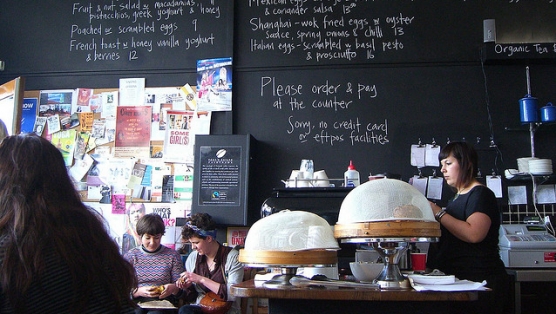Breaking Vegetarian: Restaurant Survival Guide
Paste's column on eating meat mindfully
Flickr/Ed Kwon
In what is probably my favorite episode of Portlandia, Carrie and Fred play conscious carnivores who visit an upscale farm-to-table restaurant, and want to know everything they can about their food before they order it. The scene is a hilarious parody of the ethical eater: the server provides them with more detail than anyone could dream of about the chicken they’re considering, returning to the table with a portfolio that includes his organic certification papers, a photo, and his name (Colin). But even still, the diners want more. They grill the server about Colin’s living conditions, asking if he had little chicken friends. In my favorite moment, Carrie exclaims, “I mean, who are these people raising Colin?” before eventually, the pair leaves the restaurant to visit Colin’s farm before ordering.
Obviously, the scene’s humor comes from its taking the concerns of ethical eaters to a not-unbelievable extreme, and I like to be able to laugh at myself. But still, the scene had me thinking: how do you do that in real life? As an eater with certain ethical principles, how do I dine out without becoming those people?
Figuring out the sourcing of ingredients can be tricky at certain restaurants. Even as some restaurants list local farms on their menu, others might not be forthcoming with the information, and it can feel embarrassing to ask. The first, and easiest, way to make the process of dining out easier on your ethics is simply to choose your restaurant wisely. There are plenty of farm-to-table / seasonal / vegetarian / gastropub joints to go around these days, and knowing their farmers (and those farmers’ methods) is a key part of their restaurant identity. They are happy to talk about it.
I find the most rewarding part of being an ethical eater learning my local hot-spots, and getting recommendations for great local and sustainably-sourced restaurants when I travel. I make sure to spend time asking friends, or browsing on Urbanspoon. But I also like to turn to the local farm-to-table or sustainable farming organizations, or visit the farmer’s markets to chat with the source. Farmers are proud to tell you which restaurants in the area buy their food, and you might be surprised by some of the answers. It’s fun, and it reminds me of why I stopped being a vegetarian in the first place: to participate. I want to get to know the other people—farmers, eaters, and chefs—building the sustainable food community I’m trying to help create.
Ames, Iowa, where I went to graduate school has an amazing farm-to-table treasure in The Café, which features a rotating seasonal menu and a kitchen that develops entrees based on the best products available from their local farm sources. When I met Mike DiStefano, the owner of Numero Uno in Johnstown, Pennsylvania, I was surprised to have him explain that he bought all the meat and fresh produce from a handful of local farms I knew well from the market. This was a casual Italian place in a strip mall seventy miles from the nearest metropolitan center.
Of course, restaurants like this aren’t everywhere, not yet, and though a pleasant surprise is nice, you can’t necessarily count on it when you dine out. So what to do if you find yourself in a restaurant without a clear sense of where and how they source their meat? Me, I remember my vegetarian training for this. When I’m faced with a menu, I always look to the vegetarian option first. I find the more creative and delicious a vegetarian option sounds, the more likely it is that the restaurant has spent time thinking about ethical diets and how to accommodate them.
And remember, simple doesn’t necessarily mean basic. A restaurant with menu items that highlight the ingredients, and don’t fuss over them too much, is a restaurant with high-quality ingredients, which are likely to come from the area. A rotating menu is also a good sign, as it indicates a chef in touch with the flavors of the local seasons, and with nearby farm sources for those ingredients.
If, however, I’m not at a restaurant that offers up this kind of information freely, here are a couple questions I’ll ask the servers to figure out what might best fit my ethical framework.
If, however, I’m not at a restaurant that offers up this kind of information freely, here are a couple questions I’ll ask the servers to figure out what might best fit my ethical framework.
What’s the freshest meat you’ve got?
-

-

-

-

-

-

-

-

-

-

-

-

-

-

-

-

-

-

-

-

-

-

-

-

-

-

-

-

-

-

-

-

-

-

-

-

-

-

-

-









































